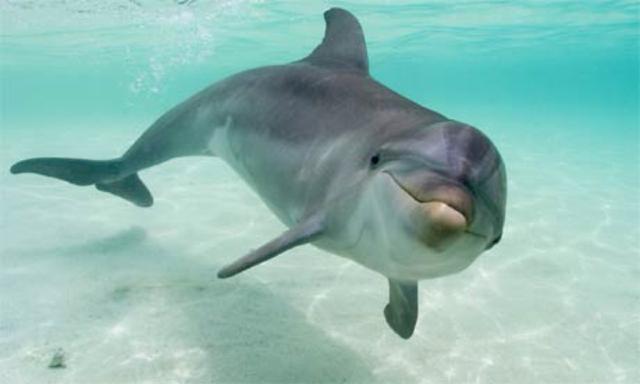(单词翻译:单击)
听力文本
This is Scientific American — 60-Second Science. I'm Karen Hopkin.
Got a minute?
Sometimes a snout full of snot can be just what the doctor ordered. At least if you're a dolphin. Because a new study shows that a little bit of mucus helps these marine mammals generate the rapid-fire stream of clicks they emit and use for echolocation.
First off, let's just get this out of the way. Dolphins do not actually sound like this. [Flipper laugh sound] That's a made-for-TV giggle that some say is actually the doctored call of a bird: the Australian kookaburra.
Real dolphins, like these bottlenoses, sound more like this. [Bottlenose sounds] They use their clicks, chirps and whistles to navigate, communicate and to catch their next meal. The high-frequency clicks, in particular, help Flipper and his kind locate and track fish dinners.
Dolphins make these sounds by forcing air through a nasal passage just beneath the blowhole. In this nasal region are liplike flaps of tissue called dorsal bursae that vibrate and collide to produce dolphin talk.

Now, a team of researchers has created a simplified model that can reproduce this characteristic dolphin chatter. And they found that the secret ingredient is snot.
While looking through the literature, oceanographer Aaron Thode stumbled across a model that represented vocal cords as masses connected by springs—which store and release energy—and dampers, which dissipate that energy. This model successfully replicated the essential characteristics of the system, like the frequency of vocal cord vibration.
So Thode enlisted his father Lester, a retired nuclear physicist from Los Alamos National Lab, to help him fit the model to a dolphin's nasal anatomy. When the Thodes compared the simulated sounds produced by their model to a recording of actual dolphins, they found that the model mimicked both the loud thump and extended ring that are part of the natural click. That's the sound, but slowed down to make it audible to our ears.
The initial thud comes from when those dorsal bursae collide. And the reverberation results from the vibrations that linger when the tissues pull apart. But Thode the younger says the bursae have to be somewhat sticky for the clapping together and snapping apart to produce a noise with the correct loudness and pitch. That stickiness comes courtesy of the mucus. Thode vocalized the results at the meeting of the Acoustical Society in Salt Lake City.
The match between the simulated sounds and the real deal is encouraging, and the Thodes plan to keep up their collaboration to refine their model. "Yeah, I guess some fathers and sons bond over football, but my dad and I, I guess we bonded over differential equations and writing this paper."
Thanks for listening for Scientific American — 60-Second Science Science. I'm Karen Hopkin.
参考译文
这里是科学美国人——60秒科学。我是凯伦·霍普金。
有一分钟时间吗?
如果你是一只海豚,医生会要求你鼻子里充满鼻涕。因为一项新研究表明,一点粘液有助于这些海洋哺乳动物发出急速连续的咔哒声并利用回声进行定位。
首先,我们要说明一下。海豚实际上并不会发出这样的声音。(海豚飞宝的笑声)这种咯咯的笑声出自一部电视电影,有人说那实际上是用澳大利亚笑翠鸟的叫声伪造的。
真正的海豚,像这些宽吻海豚,它们的声音听起来更像这样。(宽吻海豚的声音)它们通过发出的咔哒声、啾啾声和口哨声来进行导航、交流和捕食。尤其高频咔哒声可以帮助海豚飞宝和它的同类进行定位,追踪用作晚餐的鱼类。
海豚迫使空气穿过气孔之下的鼻道制造出声音。海豚的鼻区有被称为背侧黏液囊的唇形片状瓣膜,通过振动和碰撞让海豚能够“讲话”。
现在,一个研究小组建立了一个可重现海豚叫声特征的简化模型。他们发现,秘密成分是鼻涕。
在浏览文献时,海洋学家亚伦·索德偶然发现了一个模型,这个模型将声带描绘成由弹簧相连、可以储藏和释放能量的集块,以及消散能量的阻尼器。这一模型成功地复制了发声系统的基本特征,如声带振动的频率。
索德的父亲是美国洛斯阿拉莫斯国家实验室的退休核物理学家,索德邀请他的父亲莱斯特加入研究,帮助他使这个模型与海豚的鼻部解剖构造相符合。当他们将模型产生的模拟声音与海豚真实声音的录音进行比较时,他们发现,这个模型模拟的撞击声和延长形成的环状结构就是海豚发出的咔哒声的一部分。这就是模型发出的声音,不过我们放慢了速度让大家可以听清。
最初的撞击声来自背侧黏液囊的碰撞。而回声则来源于组织分离时产生的振动。不过小索德认为,黏液囊必须要有足够的粘性,一下靠拢又分开,才能产生这种声音并达到正确的音量和音高。这种粘性来自粘液。索德在盐湖城举行的声学学会上发表了这一研究成果。
模拟声音与海豚原声的匹配度令人鼓舞,索德父子计划继续合作下去,完善他们的模型。“我认为有些父子因足球而亲密,而我爸爸和我是因为微分方程和撰写这篇论文而亲密起来的。”
谢谢大家收听科学美国人——60秒科学。我是我是凯伦·霍普金。
译文为可可英语翻译,未经授权请勿转载!
重点讲解
重点讲解:
1. in particular 尤其;特别;
例句:She stressed that point in particular.
她特别强调了那一点。
2. stumble across 意外发现;偶然看见;
例句:I stumbled across an extremely simple but very exact method for understanding where my money went.
我意外发现了一个非常简单却能精确了解我所花钱去向的方法。
3. part of 一些;部分;
例句:The astronaut accepted danger was part of the job.
太空人承认他们的工作中包含著危险。
4. keep up 继续做(或提供);
例句:You can't keep up the pretense any longer.
你无法继续伪装下去了。


